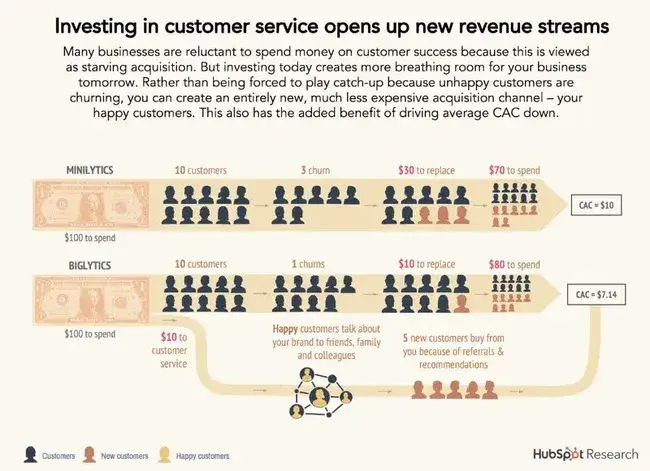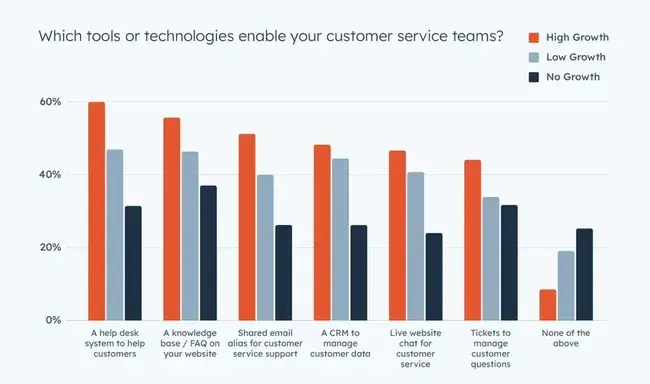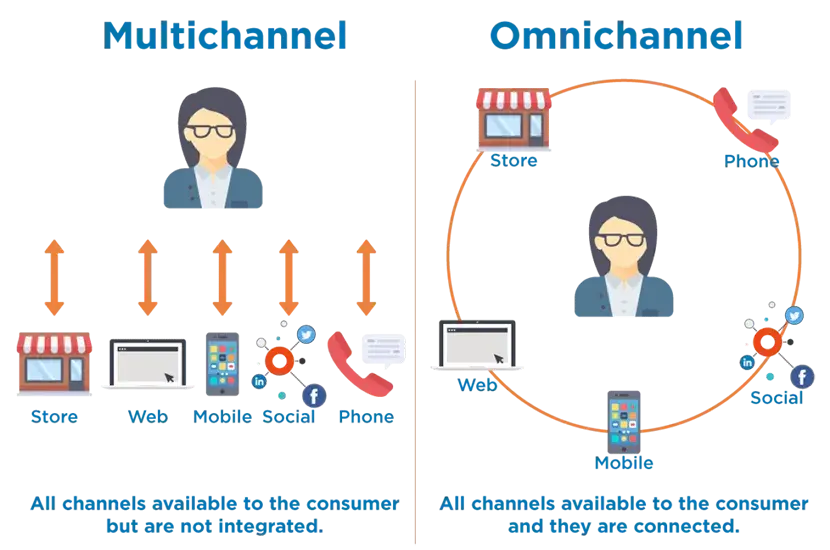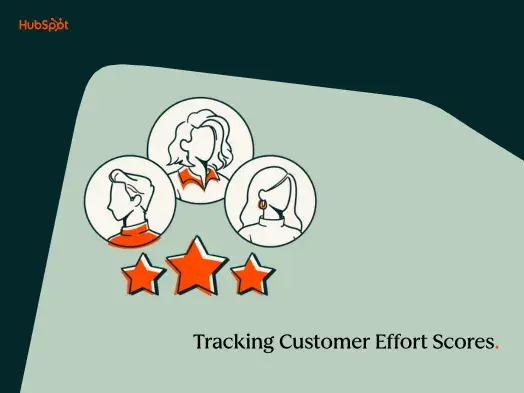Table of Contents
- Why is customer service important?
- Financial Benefits of Excellent Customer Service
- How Customer Service Supports Marketing Success
- Customer Service’s Impact on Brand Image
- The Power of Well-Equipped Employees
- What Businesses Need to Improve Customer Service
- Invest in Your Customer Service Team Today
Why is customer service important?
Customer service is important because it's the direct connection between your customers and your business. It retains customers and extracts more value from them. By providing top-notch customer service, businesses can recoup customer acquisition costs. This helps to cultivate a loyal following that refers new customers, serves as case studies, and provides testimonials and reviews.
This direct connection not only helps retain customers but also turns them into advocates for your brand.
I’ve found that by investing in proactive support and personalized experiences, we can turn satisfied customers into loyal promoters who actively contribute to the growth of the business. It’s the essence of what we call the ‘flywheel’ — a continuous loop where happy customers fuel further growth through referrals, testimonials, and repeat business.
Financial Benefits of Excellent Customer Service
A company that prioritizes excellent customer service isn’t just responding to queries or resolving issues. It’s actively driving revenue and boosting profitability. In fact, improving customer experience can increase sales revenue by 2-7% and profitability by 1-2%.
Let’s delve deeper into the financial benefits of a top-notch customer service team:
1. Customer retention is cheaper than customer acquisition.
Acquiring a new customer is significantly more expensive than retaining an existing one. According to our research, companies that fail to invest even a small percentage of their budget in customer service face higher customer acquisition costs (CAC).
Investing in customer service doesn’t just reduce churn —it directly lowers CAC by decreasing the need to constantly replace lost customers.
Every successful startup I’ve worked with over the past decade has prioritized customer service and customer success teams with this goal in mind.

Why is customer retention so important?
- Repeat customers are more profitable: Studies show that 20% of your current customers generate 80% of your profits. Retaining and nurturing this group is essential for long-term growth.
- Positive experiences drive loyalty: When customers have a great first experience, they’re far more likely to return. Satisfied customers not only stick around but also spend more over time. I’ve seen this personally while working on the Insider loyalty program at Skybound Entertainment as it drove repeat purchases and long-term advocacy.
Pro tip: Focus on crafting exceptional customer experiences to boost retention. Start with a stellar onboarding process and personalized offers. According to McKinsey, companies with experience-led growth strategies enjoy 5-10% higher wallet share and 20-30% higher customer satisfaction and engagement –– a win-win for both customers and your bottom line.
2. Customers will pay more to companies with better customer service.
Another thing I’ve learned over the years is that great service pays off, literally. An extraordinary number of customers are willing to pay a premium for businesses that prioritize exceptional service. Over 80% of customers report that receiving value during a service experience makes them more likely to repurchase, even when given the option to switch to a competitor.
Why does customer service make such a difference?
- Service builds loyalty: A single positive experience can solidify a customer’s commitment to your brand, while one negative interaction can send them straight to your competitor.
- Customers value respect: People notice when your team treats them with care and empathy, and they reward that effort with repeat business.
I’ve definitely witnessed this firsthand at Skybound with the Insider loyalty program and aspects of community management. When you solve for the customer, whether it’s through quick resolutions or thoughtful conversations, they stick around and support you more. Creating communities is a great way to foster this type of relationship.
Pro tip: To deliver the kind of customer service that drives loyalty and revenue, focus on these essentials.
- Resolve issues promptly and accurately.
- Listen actively and show you genuinely care about the customer’s concerns.
- Meet customers where they are, no matter the channel.
- Take customer insights seriously and refine your processes to keep their needs front and center.
I know you might be thinking this seems like a lot, but it becomes manageable and scalable with an all-in-one customer service solution. In my experience, investing in the right tools can really take your capabilities to new heights.
3. Customer service grows customer lifetime value.
Customer lifetime value (CLV) is a really important metric for any business. It measures the total revenue a single customer generates over the entire duration of their relationship with your company.
From my experience, increasing CLV requires a strategic and intentional focus on exceptional customer service. At Dapper Labs, for example, we achieved a significant CLV increase by implementing conversational AI chatbots. These chatbots managed 70% of incoming support requests (later more), which allowed our human agents to focus on solving complex customer issues and fostering deeper, more meaningful connections.
How does exceptional customer service boost CLV?
- Increased customer satisfaction: Positive support experiences encourage loyalty and drive repeat business.
- Enhanced brand loyalty: When customers feel valued and supported, they stick around longer.
- Effective upselling and cross-selling: Trust built through exceptional service makes customers more receptive to product recommendations, driving higher sales through cross-selling.
Pro Tip: Use customer service research and machine learning to predict CLV and inform your marketing strategies. Predictive CLV models, powered by AI, use historical customer behavior patterns to forecast how much value a customer will bring over their journey with your brand. These insights can help identify high-value customers, optimize your acquisition costs, and tailor personalized marketing efforts to retain them more effectively.
4. Customer service can lead to more revenue.
Business leaders know that profitability isn’t just about budgeting wisely, but it’s also about how customer experience can directly drive revenue. Research shows that companies focusing on CX see twice the revenue growth compared to their peers, and this trend has held steady for the past decade.
At Skybound, we leaned into this idea during the holiday shopping season on our online store. We set up our customer service team for success by giving them the tools and insights they needed to handle questions and concerns without delay. We made sure they had real-time inventory access and communication strategies to address common issues like order timing and shipping delays.
On top of that, agents took a proactive approach by offering tailored product suggestions that aligned with ongoing promotions –– helping customers unlock discounts, bundle deals, or free shipping, making the shopping journey seamless and rewarding.
CX is an investment that improves experiences and financial performance.
Pro tip: Empower your team with the right tools and proactive strategies during busy periods. Offering personalized promotions and quick, empathetic responses can turn inquiries into lasting customer relationships and sales opportunities.
How Customer Service Supports Marketing Success
Customer service team members are on the frontlines, communicating daily with current and potential customers. As a result of this proximity, customer service can offer valuable insight that can help improve marketing outcomes.
1. Customer service employees can offer important insights about customer experiences.
Often, how you see your brand privately is different from how your customers see it.
For example, an athletic wear business might market itself as health and fitness-focused, but people might buy from them more for comfort or style. To tailor your message and product strategy, you need to understand these subtleties.
One of the best ways to get this information is to talk to your customer service team. Every day, they talk to customers and find out what works and what doesn’t, as well as why people keep coming back. You can turn these exchanges into useful data by giving them the right tools and training. As a suggestion, you can build an AI-powered chatbot based on the best LLMs to help analyze conversations and understand key trends.
We used this approach a lot during important campaigns at Skybound. By letting agents record common themes from their interactions, we learned surprising things about why customers purchased, which helped us improve our products and send more targeted marketing messages.
Businesses get more than just happy customers when they put money into knowing and improving the customer journey. In fact, 73% of businesses that give their customers an above-average experience do better financially than their competitors.
There is a clear link between putting customer happiness first and long-term growth and profit. It’s not just the right thing to do; it works.
2. Proactive customer service creates marketing opportunities.
People often think of customer service as an action-based job that deals with issues as they come up. But taking a more proactive method has big advantages.
Businesses that get in touch with customers before problems happen show that they want to make their experience better. This not only makes people happier, but it also makes business possible.
Proactive service empowers you to instantly provide customers with the latest goods, features, or solutions they need. Your team can reach out to someone who had a problem in the past to let them know about a new feature that will fix that particular issue. This makes the contact feel personal and up-to-date.
60% of customers say that “representatives responding quickly and bringing quick solutions” is the top factor that encourages them to make repeat purchases. Proactive service helps mitigate this by engaging customers early, preventing dissatisfaction, and even turning service interactions into sales opportunities.
3. Personalized customer service can improve your online conversion rate.
Your online conversion rate can improve by 8% when you include personalized consumer experiences. A higher conversion rate should lead to more sales and more revenue. Customer service keeps your flywheel moving, like marketing and sales.
However, service that isn’t personalized and makes customers feel like no more than a ticket number in the system harms customer retention. Of customers, 62% think businesses can do more in terms of personalization because they’d prefer to feel like an experience is all about them.
Data supports that great customer service is an expectation, not a frivilous bonus. You'll attract new customers, prevent customer churn, and build your brand reputation and image with excellent customer service.
Customer Service’s Impact on Brand Image
Every company is known for its customer service to some degree. Of course, you always want a positive brand image, and customer service can be a significant determining factor.
1. Customer service affects your brand image and loyalty potential.
Your customer service team is often the first point of direct contact between your brand and potential buyers. While marketing campaigns and content build awareness, it’s the customer service experience that truly shapes how customers view your brand and whether they remain loyal.
It also plays a huge role in converting first-time buyers into repeat customers. Research shows that 89% of customers are more likely to return after a positive customer service interaction.
In fact, for 66% of customers, a brand’s reputation for customer service is a key factor when making a purchasing decision. On the flip side, poor service can cause customers to cut ties with a brand.
It’s proven that investing in a customer service team that aligns with your brand’s values is crucial for long-term success and customer retention.
2. Excellent customer service will protect relationships with customers who experience a mistake down the road.
Poor customer service can cause significant damage to your business, especially as more customers are vocal about their negative experiences. 51% of B2B companies will stop doing business with a vendor after a bad customer service experience.
Customers are also quick to leave companies that don’t meet their expectations. Roughly 86% of customers would leave a brand after even just two poor experiences.
However, the story isn’t all negative. If your company provides excellent customer service, 78% of customers are willing to give you a second chance after a mistake.
Studies have shown over and over that customers are more loyal to companies that fix problems quickly and correctly than to companies that have never had a problem in the first place. This is called the “service recovery paradox,” and it shows how important it is to not only avoid mistakes as much as possible, but also make sure systems are ready for when they do happen.
From what I’ve seen, companies that can turn a bad situation around are the ones that give their employees the tools they need to handle issues with care and speed.
3. A positive customer service reputation makes people more likely to do business with you.
It’s obvious now that outstanding customer service is a significant differentiator. Even in highly competitive markets with equal products and pricing, businesses that focus on customer experience can gain an advantage.
Consider this: if two organizations offer essentially the same product, but one gives great service, which one will you likely choose?
According to research, positive interactions increase customer loyalty even in the face of rival offers. Customers will stick with a brand that they trust and feel appreciated by.
In today’s digital age, where word-of-mouth spreads quickly online via reviews, social media, and forums, a great reputation for customer service is essential. It’s become a major driver of new customer acquisition and overall business success.
The Power of Well-Equipped Employees
If a company doesn’t appreciate and properly resource its customer service team, it will show in the quality of service that customers receive. But when companies provide the proper training and work environment, customer service employees become a powerful force to turn satisfied customers into loyal advocates who fuel your business.
1. Happy customer service employees will create happy customers.
It’s simple: happy customer service employees create happy customers — and the numbers prove it.
Our annual State of Service report found that when companies invest in their service teams by providing proper training, tools, and support, it leads to better outcomes for both employees and customers.
Motivated, well-equipped reps deliver quicker, more personalized service, which boosts customer satisfaction. In fact, happy employees can lead to a 13% increase in productivity. That kind of boost makes a huge difference in meeting customer expectations, keeping them satisfied, and driving more loyalty. This is true for both B2B and B2C environments.
It’s surprising that so many companies miss this link. In my experience, too many leaders still treat customer service as a cost center instead of recognizing it as a key growth driver.
However, the companies that priortize their teams see real results. Engaged employees are better able to meet the rising demand for fast and efficient service. By investing in your people and the right tools, you’re not only creating a positive work environment but also ensuring happier customers –– leading to long-term success.
2. Happy customers will refer others.
When people have a memorable experience — good or bad — it’s natural to want to shout about it from the rooftops. But, of course, today’s rooftops are review websites and social media, with 55% of consumers sharing their purchases socially on Facebook, Twitter, Pinterest, and other social sites.
For better or worse, your most impacted customers will do word-of-mouth advertising for you. In fact, 66% of salespeople say that the highest quality leads come from existing customers. Since great customer service translates to happy customers, your customer service team can be a major catalyst for cheap promotion through positive word-of-mouth and referrals.
Much like your most loyal customers, referred customers are a business treasure. Referred customers:
- Refer 30-57% more new customers than others
- Help businesses generate 3-5 times higher conversions
- Are 4x more likely to buy when referred by a friend
Customers who feel genuinely valued are not only more likely to return, but they’ll also actively become your best advocates. A referred customer from a happy one is a trust bridge built on positive experiences, and it’s the kind of growth that’s both organic and sustainable.
3. Good customer service encourages customers to remain loyal.
As we’ve covered, it‘s much cheaper to retain an old customer than to acquire a new one. So, in this sense, the higher a customer’s lifetime value — the total revenue a company can expect a single customer to generate throughout their relationship with that company — the higher the profit for your company.
Compared to hundreds of possible competitors with similar products and services, your company has to do more than relish the exciting features of your products. You can differentiate from your competitors by providing stellar customer service. This is especially true when it’s time to launch a new product or service.
Your existing customers are 50% more likely to try a new product and spend 31% more money on it than new customers. In fact, new customers are only 5-20% likely to buy a product.
For those existing customers to stay long enough to consider a new product, it takes effort via customer service to keep them satisfied. Of customers, 71% cited poor customer service as the reason they ended a relationship with a company.
Conversely, when your company’s customer service is excellent, you’re more likely to see your customers stick around and eventually try more of your offerings.
Loyalty is rooted in trust, and customers can trust real-life humans more than the ideas and values of a brand. So, by interacting with your customer service team, those customers can hopefully build life-long relationships with your business.
What Businesses Need to Improve Customer Service
Beyond understanding how essential it is to put considerable effort into building a solid customer service team, companies need to provide employees with all the tools they need to deliver the type of consistent, proactive customer service required today.
Here are a few areas to keep in mind when improving your customer service team:
1. Customers expect high-quality service.
Your team needs to be world-class and ready to meet customer demands at a moment’s notice.
Research shows that 76% of consumers expect connected interactions across all channels, but a majority, 54%, feel their experiences are often fragmented across sales, marketing, and service teams. On top of this, 58% of customers say their service expectations have increased since the pandemic. Consumers demand service that is personalized and consistent.
This is where businesses can capitalize on their CX strategy. The gap in customer expectations and actual delivery leaves room for improvement. With competition at an all-time high and customers having endless options, it’s clear that meeting these expectations is no longer a luxury.
2. Businesses need omnichannel solutions.
In the past decade, businesses gradually explored new, digital ways to engage and support customers. But, over the past few years, this timeline accelerated significantly. As we pointed out, consumers expect service across all channels.
As we shared in our State of Service report, only 50% of companies have enabled their service teams with the most basic service features a CRM can provide: a help desk, knowledge base, and shared email capabilities.
As a result, many businesses have much catching up to do to provide their customer service teams with the tools they need to serve customers well across every channel.
Considering this is also one of the highest ROI strategies for CS teams, count omnichannel solutions as a major growth area in the future.

The image below explains how omnichannel experiences work:

Rather than having each channel operate independently, the channels link together so they can share messages and information freely. That way, customers don’t have to navigate away from what they’re doing to get help from your business.
Instead, any time they need help, they can reach out on any channel of their choice and will get an immediate, reliable response.
3. Excellent customer service is a competitive advantage.
Excellent customer service has always been a major differentiator, and it’s only becoming more crucial. According to a Zendesk report, when businesses offer quick, effective, and personalized support, they not only keep their existing customers but also attract new customers from competitors.
Personalization is key. Our own research found that 78% of customers expect it, and 44% are more likely to return after a personalized experience. Customer loyalty is tightly connected to how much personalized attention they get. A solid customer service experience can increase revenue, as businesses that understand and meet customer needs build deeper, longer-lasting relationships.
By delivering fast, personalized service and addressing issues quickly, your company can stand out, grow, and gain a competitive edge.
As Jeff Bezos famously said, “We see our customers as invited guests to a party, and we are the hosts. It’s our job every day to make every important aspect of the customer experience a little bit better.”
4. Phone support still matters — even in a digital world.
Invest in Your Customer Service Team Today
Writing this has reminded me of the undeniable connection between investing in customer service and driving business success. When businesses prioritize their customer service teams (by recruiting top talent, offering the right training, and equipping them with the best tools), they build a foundation that supports long-term growth.
What I’ve further realized through this process is that customer service is far more than a support function. It’s a core part of your brand and customer experience, capable of shaping perceptions, building loyalty, and driving revenue.
So, now that I’ve seen the impact of these investments, I’m asking you: How will you raise the standard of customer service at your company? How will you invest in your team to create the kind of lasting relationships that keep customers coming back for more?
Editor's note: This article was originally published in October 2018 and has since been updated for comprehensiveness.
Customer Service







.png)

-2.png)


